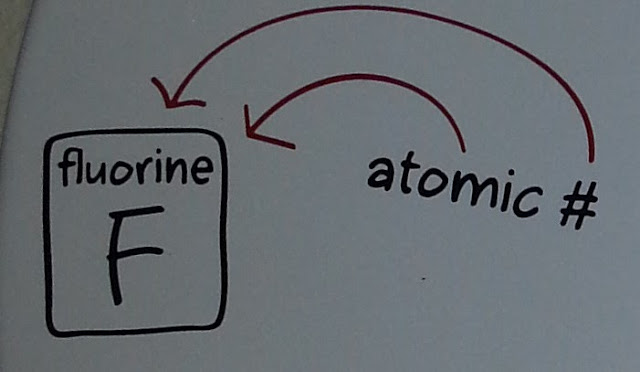This one is quite straightforward; it's just the atomic number of the element fluorine.
As you probably remember from chemistry class, each element is uniquely described by something called its atomic number. This number is simply the number of protons in the nuclei of the atoms of that element. The number of protons determines how many electrons make an electrically balanced atom, and also how many electrons the atom will strive to attain (which are only the same number in the case of the noble gases, and hydrogen, somewhat).
You see, due to some slightly complicated features in quantum mechanics that I should talk about some day, not all electron configurations are created equal in energy. Many atoms, especially of the lighter elements, try to reach the same number of electrons as the noble gas closest in atomic number to them because that represents the lowest possible energy state for them.
Fluorine is a fairly light element. Its atomic number, nine, is just above oxygen (eight), and just below the noble gas neon (ten). It therefore wants to gain one more electron to bring it into a lower energy state. Now, if you know your chemistry, you know that oxygen is a highly, highly reactive element. Fires and explosions? Caused pretty much entirely by extremely rapid reaction of oxygen in the air with certain materials. From a biological standpoint, oxygen is pretty dangerous stuff if it gets where it isn't supposed to be because it can react with so much delicate biological machinery (which makes it even more amazing that our bodies run on the stuff). Single oxygen atoms that get loose in the body are classified as free-radicals, and can contribute to cell mutations and cancer if they react with DNA. Even in bulk, diatomic oxygen (the kind we breathe) can be dangerous if you get too much of it, in a condition known as oxygen toxicity.
Now, as bad as oxygen is, fluorine is worse. Much worse. It is the most reactive and electronegative element in the universe. Oxygen can actually exist in the Earth's atmosphere for a fairly long time as a diatomic molecule. Fluorine is much too unstable for that. Although it can (and does) form a diatomic molecule when isolated by itself, once free from containment it vigorously sets to work oxidizing anything it comes into contact with extremely rapidly. Quite a lot of substances will burn frighteningly quickly upon exposure to pure fluorine, including things we don't normally think of as flammable, such as iron wool. Or water, which will burn upon exposure to fluorine.
This video, from the Periodic Videos collection, shows some reactions of fluorine with things such as iron wool, charcoal briquettes, and a lump of sulfur:
Now, fluorine may go about obtaining its extra electron very violently, prying it out of the grasp of any other atoms it comes across if it can (barring helium and neon); however, once it has achieved the low energy state it finds itself in, it's actually quite tame. Fluorine with this extra electron is called fluoride (which is an ion since it is no longer electrically neutral), and it is quite happy to share this electron with another atom leading to exceptionally strong chemical bonds.
In fact, you probably have more exposure to fluoride than you might think if you use Teflon cookware. Teflon is the brand name for a chemical known as polytetrafluoroethylene, which is pretty much nothing but long chains of carbon atoms each with two fluorine atoms attached to it. Because these fluorine atoms bind so strongly to the carbon atoms they are highly reluctant to attract anything else, which is why Teflon is so slippery (it is the third most slippery substance known, and in fact is the only known material to which a gecko cannot stick).
Fluoride is also useful in another manner than ties back to number seven on the clock: remember how in the discussion of the Mohs scale of mineral hardness I mentioned that your teeth are made of a form of apatite and thus had a hardness of about five? Well, it turns out that tooth enamel is vulnerable to decay in acidic environments, such as your mouth after drinking anything acidic (like soda) or consuming sugar (bacteria in your mouth create various acids as they consume the sugar, again lowering the pH around your teeth).
Now, it turns out that if you have fluoride ions in your mouth, they will tend to bind themselves over time to the surface of your teeth, changing the enamel from hydroxyapatite to fluorapatite, which is much more resistant to attack by acids (in essence, the fluorine atoms bind tightly to the tooth enamel, making it harder for other materials such as acids to reach the enamel). Many toothpastes now contain fluoride, and it is often added in small amounts to drinking water. The nice thing about fluoride ions is that they're inert enough that they really don't interact much with the rest of you, passing through harmlessly.
So there you go. The universe's most reactive (and one of the more dangerous) elements, serving double duty to make our dish-cleaning less tedious and our teeth better protected from cavities. All around a fascinating element, and I highly recommend you read up on it yourself – there's much more to be said about it than I can fit in this post.
Anyway, check back next time for a number from physics and biology! Click here to jump directly to it.

No comments:
Post a Comment
Think I said something interesting or insightful? Let me know what you thought! Or even just drop in and say "hi" once in a while - I always enjoy reading comments.